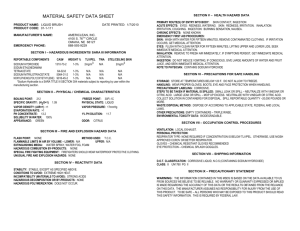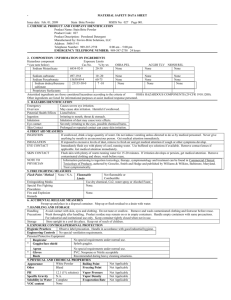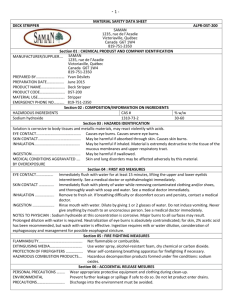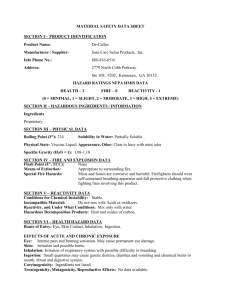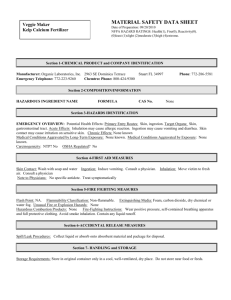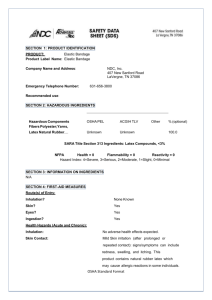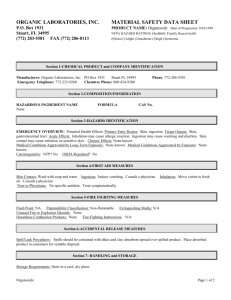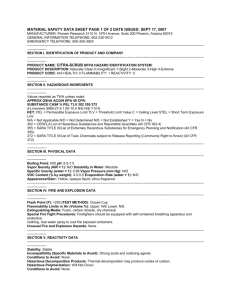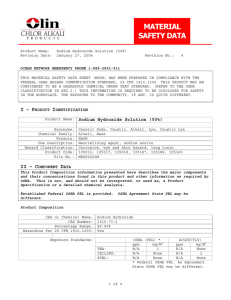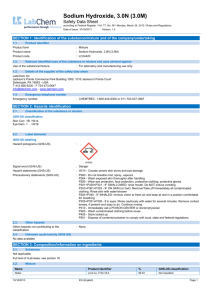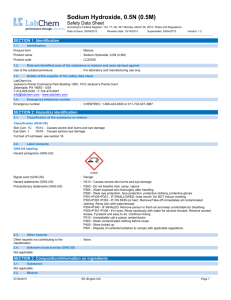Sodium Hydroxide Solution MSDS: Safety & Handling Guide
advertisement
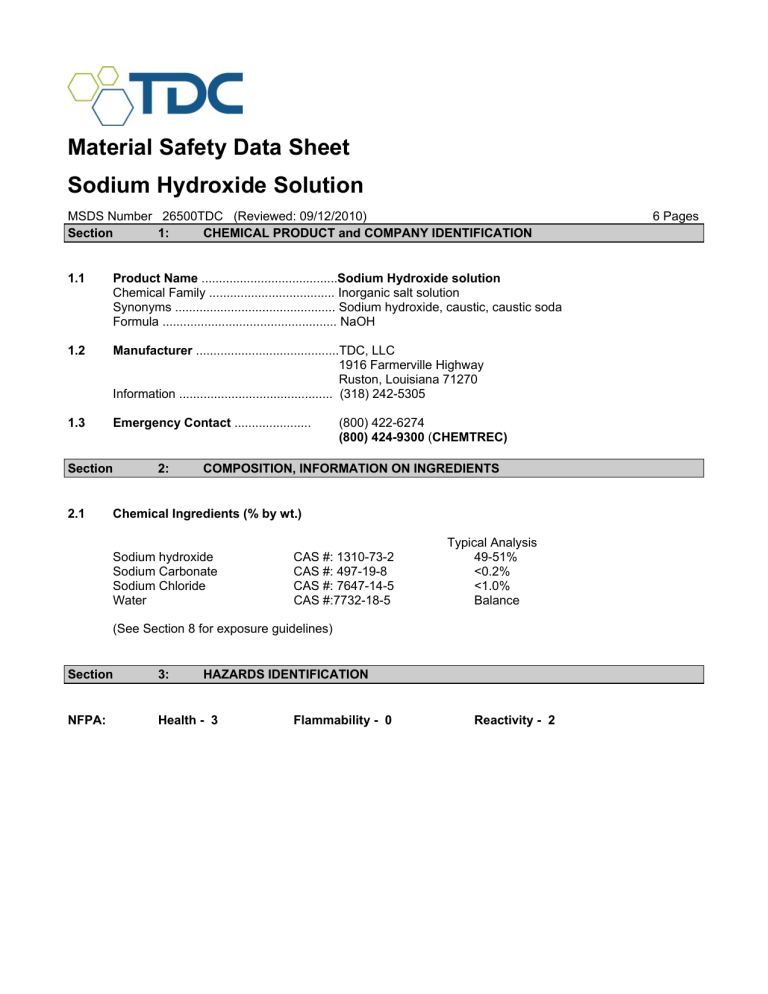
Material Safety Data Sheet Sodium Hydroxide Solution MSDS Number 26500TDC (Reviewed: 09/12/2010) Section 1: CHEMICAL PRODUCT and COMPANY IDENTIFICATION 1.1 Product Name .......................................Sodium Hydroxide solution Chemical Family .................................... Inorganic salt solution Synonyms .............................................. Sodium hydroxide, caustic, caustic soda Formula .................................................. NaOH 1.2 Manufacturer .........................................TDC, LLC 1916 Farmerville Highway Ruston, Louisiana 71270 Information ............................................ (318) 242-5305 1.3 Emergency Contact ...................... Section 2.1 2: (800) 422-6274 (800) 424-9300 (CHEMTREC) COMPOSITION, INFORMATION ON INGREDIENTS Chemical Ingredients (% by wt.) Sodium hydroxide Sodium Carbonate Sodium Chloride Water CAS #: 1310-73-2 CAS #: 497-19-8 CAS #: 7647-14-5 CAS #:7732-18-5 Typical Analysis 49-51% <0.2% <1.0% Balance (See Section 8 for exposure guidelines) Section 3: HAZARDS IDENTIFICATION NFPA: Health - 3 Flammability - 0 Reactivity - 2 6 Pages 2 Section 3: HAZARDS IDENTIFICATION (Cont.) EMERGENCY OVERVIEW Warning: Solution is highly alkaline Contact will cause marked eye irritation and possible corneal damage. Skin contact will result in irritation and possible corrosion of the skin. Ingestion will irritate/burn mouth, throat and gastrointestinal tract. 3.1 POTENTIAL HEALTH EFFECTS EYE: Contact with the eyes will cause marked eye irritation and possibly severe corneal damage. SKIN CONTACT: Contact with the skin will cause skin irritation or burning sensation. Prolonged contact will result in corrosion of the skin. SKIN ABSORPTION: Absorption is unlikely to occur. INGESTION: Ingestion will result in severe burning and corrosion of mouth, throat and the gastrointestinal tract. INHALATION: Breathing product mist or spray may cause damage to the upper respiratory tract and lung tissue which could develop into chemical pneumonia depending upon severity of exposure. CHRONIC EFFECTS/CARCINOGENICITY: Section 4: Not listed as a carcinogen by NTP, IARC or OSHA. FIRST AID MEASURES 4.1 EYES: Immediately flush with large quantities of water for 15 minutes. Hold eyelids apart during irrigation to insure thorough flushing of the entire area of the eye. Obtain immediate medical attention. 4.2 SKIN: Immediately flush with large quantities of water. Remove contaminated clothing under a safety shower. Obtain immediate medical attention 4.3 INGESTION: DO NOT INDUCE VOMITING. If victim is conscious, immediately give 2 to 4 glasses of water. If vomiting does occur, repeat fluid administration. Obtain immediate medical attention. 4.4 INHALATION: Remove victim from contaminated atmosphere. If breathing is labored, administer oxygen. If breathing has ceased, clear airway and start mouth to mouth resuscitation. If heart has stopped beating, external heart massage should be applied. Obtain immediate medical attention. Section 5: FIRE FIGHTING MEASURES 5.1 FLAMMABLE PROPERTIES FLASH POINT: Not flammable 5.2 FLAMMABLE LIMITS METHOD USED: NA NA 5.3 EXTINGUISHING MEDIA: Water spray or foam or as appropriate for combustibles involved in fire. 5.4 FIRE & EXPLOSIVE HAZARDS: Solution is non-flammable. Keep containers/storage vessels in fire area cooled with water spray. 3 Section 5: FIRE FIGHTING MEASURES, Cont. 5.5 FIRE FIGHTING EQUIPMENT: Wear self-contained breathing apparatus, positive pressure, MSHA/NIOSH (approved or equivalent) and full protective gear. Section 6: ACCIDENTAL RELEASE MEASURES 6.1 Small releases: Confine and absorb small releases on sand earth or other inert absorbent. Neutralize solution with weak (~5%) acetic acid if necessary. DO NOT NEUTRALIZE WITH STRONG MINERAL ACIDS, THIS WILL EVOLVE LARGE AMOUNTS OF HEAT. 6.2 Large releases: Wear proper protective equipment. Confine area to qualified personnel. Shut off release if safe to do so. Dike spill area to prevent runoff into sewers, drains or surface waterways (potential aquatic toxicity). Recover as much of the solution as possible. Treat remaining material as a small release (above). DO NOT NEUTRALIZE WITH STRONG MINERAL ACIDS, THIS WILL EVOLVE LARGE AMOUNTS OF HEAT. Section 7: HANDLING and STORAGE 7.1 Handling: Wear proper protective equipment (See Section 8). Avoid breathing product mist or spray. Avoid contact with skin and eyes. Use only in a well ventilated area. Dilute product only in enclosed containers. Wash thoroughly after handling. 7.2 Storage: Store in well ventilated areas. Do not store combustibles in the area of storage vessels. Keep away from any sources of heat or flame. Store tote and smaller containers out of direct sunlight at moderate temperatures [<80º F (27º C)]. (See Section 10.4 for materials of construction) Section 8: EXPOSURE CONTROLS, PERSONAL PROTECTION 8.1 RESPIRATORY PROTECTION: If working near open container or storage vessel opening or open tank truck dome cover, wear self-contained breathing apparatus, positive pressure, MSHA/NIOSH (approved or equivalent). 8.2 SKIN PROTECTION: Neoprene rubber gloves, chemical suit and boots should be worn to prevent contact with the liquid. Wash contaminated clothing prior to reuse. Contaminated leather shoes cannot be cleaned and should be discarded. 8.3 EYE PROTECTION: Chemical goggles and a full face shield. 8.4 EXPOSURE GUIDELINES: OSHA TWA 2 ppm ACGIH STEL TLV STEL 2 ppm (ceiling) 8.5 ENGINEERING CONTROLS: Use adequate exhaust ventilation to prevent inhalation of product vapors. Where feasible scrub process or storage vessel vapors with caustic solution. Maintain eyewash/safety shower in areas where chemical is handled. 4 Section 9: PHYSICAL and CHEMICAL PROPERTIES 9.1 APPEARANCE: 9.2 ODOR: 9.3 BOILING POINT: 9.4 VAPOR PRESSURE: 9.5 VAPOR DENSITY: (Air = 1.0) 9.6 SOLUBILITY IN WATER: 9.7 SPECIFIC GRAVITY: 9.8 FREEZING POINT: 9.9 pH: 9.10 VOLATILE: Section 10: Colorless to slightly hazy liquid. No distinct odor. 293ºF (145ºC) 1.5 mm Hg, (0.2 Pa) @ 20°C Not applicable Complete 1.52 (12.66 lbs/gal) @ 20°C Approximately 58ºF (14ºC) 14.0 Not determined STABILITY and REACTIVITY 10.1 STABILITY: This is a stable material 10.2 HAZARDOUS POLYMERIZATION: Will not occur. 10.3 HAZARDOUS DECOMPOSITION PRODUCTS: None 10.4 INCOMPATIBILITY: Acids will cause the release of heat. Sodium hydroxide solution is not compatible with zinc, aluminum or their alloys (i.e. galvanized metals, etc.). These materials of construction should not be used in handling systems or storage containers for this product. (SEE Section 7.2, Storage) Section 11: TOXICOLOGICAL INFORMATION 11.1 ORAL: Data not available 11.2 DERMAL: LD50: 1350 mg/kg (rabbit) 11.3 INHALATION: Not available 11.4 CHRONIC/CARCINOGENICITY: No evidence available 11.5 TERATOLOGY: Data not available 11.6 REPRODUCTION: Data not available 11.7 MUTAGENICITY: Data not available Section None available 12: ECOLOGICAL INFORMATION 5 Section 13: DISPOSAL CONSIDERATIONS If released to the environment for other than its intended purpose, this product pH will be high enough to meet the definition of a corrosive waste, D002. DO NOT ALLOW into any sewers, on the ground, or into any body of water. Section 14: TRANSPORT INFORMATION 14.1 DOT Shipping Name: Sodium hydroxide solution 14.2 DOT Hazard Class: 8 14.3 UN/NA Number: UN1824 14.4 Packing Group: II 14.5 DOT Placard: Corrosive 14.6 DOT Label(s): Corrosive 14.7 IMO Shipping Name: Sodium hydroxide solution 14.8 RQ (Reportable Quantity): 1,000 lbs (454 Kg) 100% basis 14.9 RR STCC Number: Section 15: REGULATORY INFORMATION 15.1 OSHA: This product is listed as a hazardous material under criteria of the Federal OSHA Hazard Communication Standard, 29 CFR 1910.1200. 15.2 SARA TITLE III: a. EHS (Extremely Hazardous Substance) List: No b. Section 311/312, (Tier I,II) Categories: Yes No No Yes No c. Section 313 (Toxic Release Report-Form R): No d. TPQ (Threshold Planning Quantity): No 15.3 CERCLA/SUPERFUND: RQ (Reportable Quantity) Immediate (acute) Fire Sudden release Reactivity Delayed (chronic) 1,000 lbs (454 Kg) 15.4 TSCA (Toxic Substance Control Act) Inventory List: Yes 15.5 RCRA (Resource Conservation and Recovery Act) Status: Yes (See Section 13) 15.6 WHMIS (Canada) Hazard Classification: E 15.7 DOT Hazardous Material: (See Section 14) Yes 15.8 CAA Hazardous Air Pollutant (HAP) No 6 Section 16: OTHER INFORMATION REVISIONS: The MSDS was formatted to comply with ANSI Standard Z400.1-2004 Revised Logo and Emergency Telephone Number, 02/23/2007. Reviewed 9/12/10. THE INFORMATION PUBLISHED IN THIS MATERIAL SAFETY DATA SHEET HAS BEEN COMPILED FROM OUR EXPERIENCE AND OSHA, ANSI, NFPA, DOT, ERG, AND CHRIS. IT IS THE USER’S RESPONSIBILITY TO DETERMINE THE SUITABILITY OF THIS INFORMATION FOR THE ADOPTION OF NECESSARY SAFETY PRECAUTIONS. WE RESERVE THE RIGHT TO REVISE MATERIAL SAFETY DATA SHEETS PERIODICALLY AS NEW INFORMATION BECOMES AVAILABLE.
